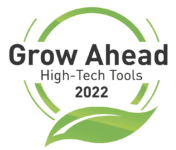

May 13, 2022Grower, researcher look at the viability of FruitScout
Mark Boyer, the former chair of the U.S. Apple Association board of directors, constantly seeks efficient and accurate ways of producing a profitable apple crop.
Boyer is the second-generation owner of Ridgetop Orchards, a grower-packer- shipper in Fishertown, Pennsylvania.


One of the mechanisms Boyer has explored on his farm is FruitScout, a precision crop load management app used on a smartphone to track buds that turn to blooms, and on through fruitlets to full-color fruit at harvest – all in an effort to pinpoint the economically optimum crop load goal.
Boyer made a presentation on his use of FruitScout, along with Penn State University Professor of Horticulture Rich Marini, at this year’s Mid-Atlantic Fruit & Vegetable Convention in Hershey, Pennsylvania.
“We have 10 different varieties of apples, all biennial bearing (which has trees that have an irregular crop load from year to year),” Boyer said. “Biennial bearing is a real problem, especially when you start growing Honeycrisp, which is our No. 1 variety at 104 acres, 84 of that in production, with 20 more coming into production. All of our apples, except for Fuji, have a parentage of Honeycrisp, which can be not so fun.”
Escalating labor costs and availability are among other reasons growers like Boyer are seeking technological solutions.
He said he was intrigued by FruitScout, “a smartphone or android system where you go out and take pictures of your trees. Within that, the idea is you’re trying to maintain the optimum crop load.”
Boyer noted that on FruitScout’s website, “it says their product has the potential to deliver between $5,000 and $10,000 per acre in increased productivity, and that 1,000 trees per acre results in additional potential income of $1 to $3 per tree.”
Ridgetop Orchards used FruitScout in an attempt to monitor fruit sizing, bud counts, counts at bloom, fruit counting, tracking the growth model and sizing.


“We took photos of a handful of trees to see how well we could get them to size,” Boyer said. “There were some (FruitScout) functions we just couldn’t use,” Boyer said. “During the thinning window, there was a little bit of lag time. The company was new, and is building staff and resources and stuff like that.
“We’ve never been successful at tracking fruitlet size because, realistically, at the end of the day in Pennsylvania you have about two windows,” Boyer said. “You’ve got one at about nine or 10 millimeters, and you have one other window after that. You are either going to thin, or you’re not going to thin. I don’t know how we overcome that. We have to be able to track fruit, I understand that. But it is a tough task. By the time that you can see fruit, basically it stops growing and it’s not going to stick around and you already have to make your decision about whether you’re going to hit it a second time.
“Applications for thinning measure fruitlets after the first round of chemical thinning and every three to seven days,” Boyer said. “We apply thinner at nine to 12 days, weather permitting, and then hopefully catch a second window later. It’s the same problem with some other models. You have one or two good windows.”
Boyer said it is essential to “get information back in real time. The (FruitScout) information was so slow (coming) back. It doesn’t save time.
“I do believe that the system will probably work better on a two-dimensional-type tree. You put this on a bigger tree, I think the harder time you’re going to have counting the fruit that’s on the tree’s back side,” Boyer said.
“There’s maybe some confusion with FruitScout and me on whether or not you can take pictures at this stage and get an accurate count. Apparently, FruitScout is saying that you can take pictures before you hand-thin, and take pictures after you hand-thin, and it will tell you how many pieces of fruit are left behind.
“Secondly, where I was hoping we could go somewhere in the future with FruitScout is preharvest photos of fruit on a tree where you can get a pre-sizer. So, whenever you go to a block you know what you’re peaking on for the packing houses so you can send in trays or bags, you know what blocks you can go to and keep those records.
“FruitScout has been really willing to work with us. That’s been great. It’s been an adventure to do this. With every type of new technology that comes out there’s a learning curve and difficulties.”
A researcher’s evaluation
Penn State’s Marini visited Boyer’s orchard to conduct an evaluation of FruitScout technology for predicting Honeycrisp blossom cluster and fruit set.
“I’ve been working on trying to predict by taking measurements of average fruit size, mostly on the research side, for 30-35 years,” Marini told the Mid-Atlantic event’s audience. “I was interested in working with Mark to see how much this system actually estimates the real thing.”
Marini’s methods included working with 15 Honeycrisp and 15 Fuji trees, each within one row. Boyer had taken photos of trunks and trees in bloom to estimated apple trunk cross-sectional area and bloom density.


“I was there a little bit after petal fall,” Marini said. “It wasn’t quite time to thin yet, but I counted the fruit clusters that had fruit on each tree. I did that about 10 days after bloom using a tape measure.”
“It was several thousand fruit, so it took me a few days,” Marini said. “I wanted to know if measuring 10 fruit per tree with the photo would do a good job in estimating the value. I used various statistical and graphical techniques to compare estimated values with observed values. “Mark and I had measured the same 15 trees.”
Marini said, “FruitScout did a pretty good job of measuring trunk size. I was quite surprised. But, in analyzing the data sets, I had never seen a situation where you have two means that are so close together and we’re correlated. I don’t get that.”
“I did same type of thing for the cluster counts. FruitScout measured one side of the tree. I did both sides. I expected my cluster counts to be higher, and they were a lot higher. It was due to some of the cross sections hiding the clusters by looking at it on just one side. The estimated (FruitScout) values were significantly less than the values that I counted. They didn’t correlate that well.
“Since then, we’ve learned that probably wasn’t the appropriate way to look at it,” Marini said. “The way we would do it is not the way FruitScout would do it. We did not know that FruitScout adjusts cluster values for occlusion, using photos before bloom, at bloom and after bloom. Therefore, we could not evaluate how well FruitScout estimated cluster counts or cluster density. The way I did it was probably not a fair comparison.”
Marini measured fruit size on Honeycrisp, using the same 15 trees, 10 fruit per tree.
“FruitScout overestimated average fruit diameter,” Marini said. “In fact, it underestimated size of the big fruit and overestimated the size of the small fruit. There’s a problem here. It’s not estimated fruit size the way I would expect. We saw the same type of things for Fuji. The estimates are bigger than the diameter. We would conclude that the diameters (comparisons) are different.
“FruitScout underestimated the size of the big fruit, and overestimated the size of the small fruit,” Marini said. “The distribution measurement was different from a statistical point of view.”
Marini said FruitScout was effective in measuring the trunk cross-sectional area (TCSA), but “tended to overestimate the fruit diameter. There are a couple of reasons. Fruit are not symmetrical. Especially Fuji, it can be sort of oblique.
“It’s also important to get a sampling of fruit that truly represents the population on the tree,” Marini said.” I’ve tried this a lot of different ways over the last 30 years. You basically have to sample 25% of the tree to get a good estimate. Mark only looked at7%to9%ofthetree,andIthinkthatis part of the problem.”
“FruitScout is an evolving machine. It’s not going anywhere,” Marini concluded. “We’re going to need technology like this if we want to stretch that dollar out.”
FruitScout upgrades set
Matt King, CEO and founder of FruitScout, who sat in on the presentation by Boyer and Marini, pointed to improvements to FruitScout’s service, and responded to the findings by the speakers.
“Mark was dead on,” King said. “Last year, in the first year of operation, we were too slow getting reports back. That was due to a lack of structure. We’ve really addressed that problem now. We guarantee to get reports back to you the next day.
“In terms of size measurements, both of those algorithms are the same thing,” King said. “It’s the same system measuring trunk size and fruit size. I’m morally obligated to agree with Dr. Marini, but I don’t think the size calibrations that we were doing were apples to apples comparisons. Those were literally different apples.
RELATED: FruitScout pinpoints cropping targets››
“The big thing I’d like to point out is that with our fruitlet growth models, you no longer have to mark back to the same fruitlets,” King said. “We’ve taken the work out of that. You just need to go take a picture and size four to five fruitlets, come back four to five heat days later, take four or five new pictures and not necessarily the same ones. We’ve taken that work down to a couple of hours instead of 10 or 20 hours.
“You have to accept that there is a difference between commercial instrumentation and research instrumentation. There’s always going to be,” King said. “The question is, when is there enough information so the grower can make a decision, and what is that information worth.”
— Gary Pullano, editor














